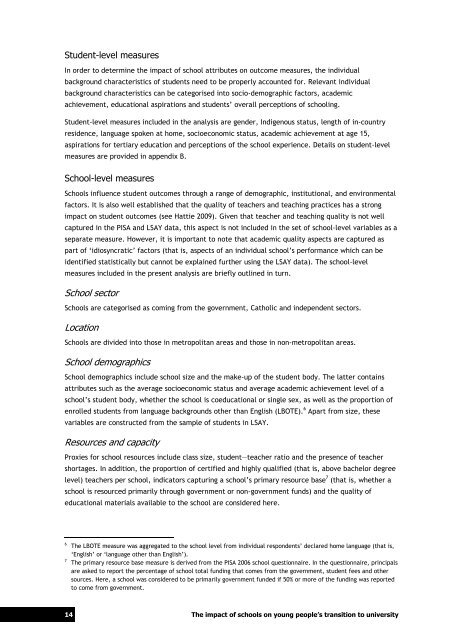The impact of schools on young people's transition to university
The impact of schools on young people's transition to university
The impact of schools on young people's transition to university
Create successful ePaper yourself
Turn your PDF publications into a flip-book with our unique Google optimized e-Paper software.
Student-level measures<br />
In order <strong>to</strong> determine the <str<strong>on</strong>g>impact</str<strong>on</strong>g> <str<strong>on</strong>g>of</str<strong>on</strong>g> school attributes <strong>on</strong> outcome measures, the individual<br />
background characteristics <str<strong>on</strong>g>of</str<strong>on</strong>g> students need <strong>to</strong> be properly accounted for. Relevant individual<br />
background characteristics can be categorised in<strong>to</strong> socio-demographic fac<strong>to</strong>rs, academic<br />
achievement, educati<strong>on</strong>al aspirati<strong>on</strong>s and students’ overall percepti<strong>on</strong>s <str<strong>on</strong>g>of</str<strong>on</strong>g> schooling.<br />
Student-level measures included in the analysis are gender, Indigenous status, length <str<strong>on</strong>g>of</str<strong>on</strong>g> in-country<br />
residence, language spoken at home, socioec<strong>on</strong>omic status, academic achievement at age 15,<br />
aspirati<strong>on</strong>s for tertiary educati<strong>on</strong> and percepti<strong>on</strong>s <str<strong>on</strong>g>of</str<strong>on</strong>g> the school experience. Details <strong>on</strong> student-level<br />
measures are provided in appendix B.<br />
School-level measures<br />
Schools influence student outcomes through a range <str<strong>on</strong>g>of</str<strong>on</strong>g> demographic, instituti<strong>on</strong>al, and envir<strong>on</strong>mental<br />
fac<strong>to</strong>rs. It is also well established that the quality <str<strong>on</strong>g>of</str<strong>on</strong>g> teachers and teaching practices has a str<strong>on</strong>g<br />
<str<strong>on</strong>g>impact</str<strong>on</strong>g> <strong>on</strong> student outcomes (see Hattie 2009). Given that teacher and teaching quality is not well<br />
captured in the PISA and LSAY data, this aspect is not included in the set <str<strong>on</strong>g>of</str<strong>on</strong>g> school-level variables as a<br />
separate measure. However, it is important <strong>to</strong> note that academic quality aspects are captured as<br />
part <str<strong>on</strong>g>of</str<strong>on</strong>g> ‘idiosyncratic’ fac<strong>to</strong>rs (that is, aspects <str<strong>on</strong>g>of</str<strong>on</strong>g> an individual school’s performance which can be<br />
identified statistically but cannot be explained further using the LSAY data). <str<strong>on</strong>g>The</str<strong>on</strong>g> school-level<br />
measures included in the present analysis are briefly outlined in turn.<br />
School sec<strong>to</strong>r<br />
Schools are categorised as coming from the government, Catholic and independent sec<strong>to</strong>rs.<br />
Locati<strong>on</strong><br />
Schools are divided in<strong>to</strong> those in metropolitan areas and those in n<strong>on</strong>-metropolitan areas.<br />
School demographics<br />
School demographics include school size and the make-up <str<strong>on</strong>g>of</str<strong>on</strong>g> the student body. <str<strong>on</strong>g>The</str<strong>on</strong>g> latter c<strong>on</strong>tains<br />
attributes such as the average socioec<strong>on</strong>omic status and average academic achievement level <str<strong>on</strong>g>of</str<strong>on</strong>g> a<br />
school’s student body, whether the school is coeducati<strong>on</strong>al or single sex, as well as the proporti<strong>on</strong> <str<strong>on</strong>g>of</str<strong>on</strong>g><br />
enrolled students from language backgrounds other than English (LBOTE). 6 Apart from size, these<br />
variables are c<strong>on</strong>structed from the sample <str<strong>on</strong>g>of</str<strong>on</strong>g> students in LSAY.<br />
Resources and capacity<br />
Proxies for school resources include class size, student—teacher ratio and the presence <str<strong>on</strong>g>of</str<strong>on</strong>g> teacher<br />
shortages. In additi<strong>on</strong>, the proporti<strong>on</strong> <str<strong>on</strong>g>of</str<strong>on</strong>g> certified and highly qualified (that is, above bachelor degree<br />
level) teachers per school, indica<strong>to</strong>rs capturing a school’s primary resource base 7 (that is, whether a<br />
school is resourced primarily through government or n<strong>on</strong>-government funds) and the quality <str<strong>on</strong>g>of</str<strong>on</strong>g><br />
educati<strong>on</strong>al materials available <strong>to</strong> the school are c<strong>on</strong>sidered here.<br />
6<br />
7<br />
<str<strong>on</strong>g>The</str<strong>on</strong>g> LBOTE measure was aggregated <strong>to</strong> the school level from individual resp<strong>on</strong>dents’ declared home language (that is,<br />
‘English’ or ‘language other than English’).<br />
<str<strong>on</strong>g>The</str<strong>on</strong>g> primary resource base measure is derived from the PISA 2006 school questi<strong>on</strong>naire. In the questi<strong>on</strong>naire, principals<br />
are asked <strong>to</strong> report the percentage <str<strong>on</strong>g>of</str<strong>on</strong>g> school <strong>to</strong>tal funding that comes from the government, student fees and other<br />
sources. Here, a school was c<strong>on</strong>sidered <strong>to</strong> be primarily government funded if 50% or more <str<strong>on</strong>g>of</str<strong>on</strong>g> the funding was reported<br />
<strong>to</strong> come from government.<br />
14 <str<strong>on</strong>g>The</str<strong>on</strong>g> <str<strong>on</strong>g>impact</str<strong>on</strong>g> <str<strong>on</strong>g>of</str<strong>on</strong>g> <str<strong>on</strong>g>schools</str<strong>on</strong>g> <strong>on</strong> <strong>young</strong> people’s transiti<strong>on</strong> <strong>to</strong> <strong>university</strong>


